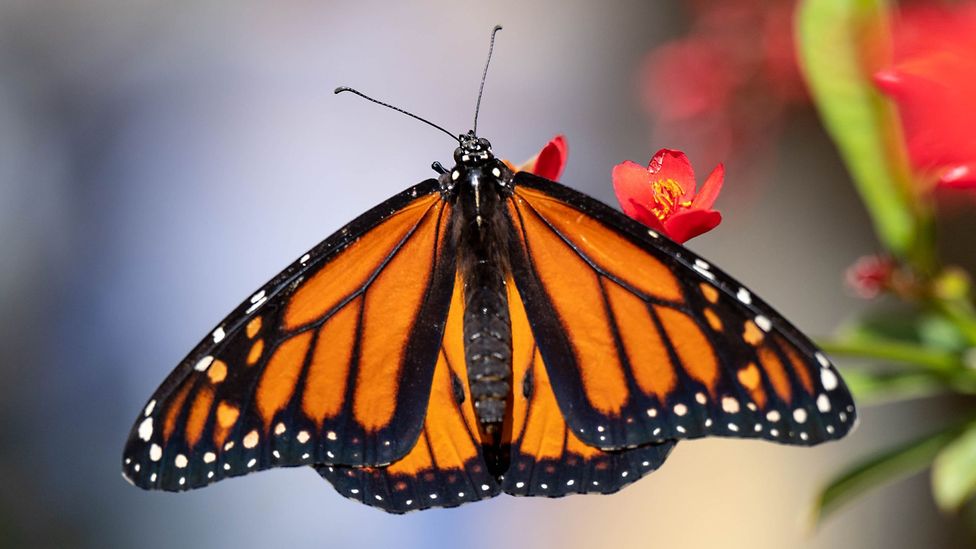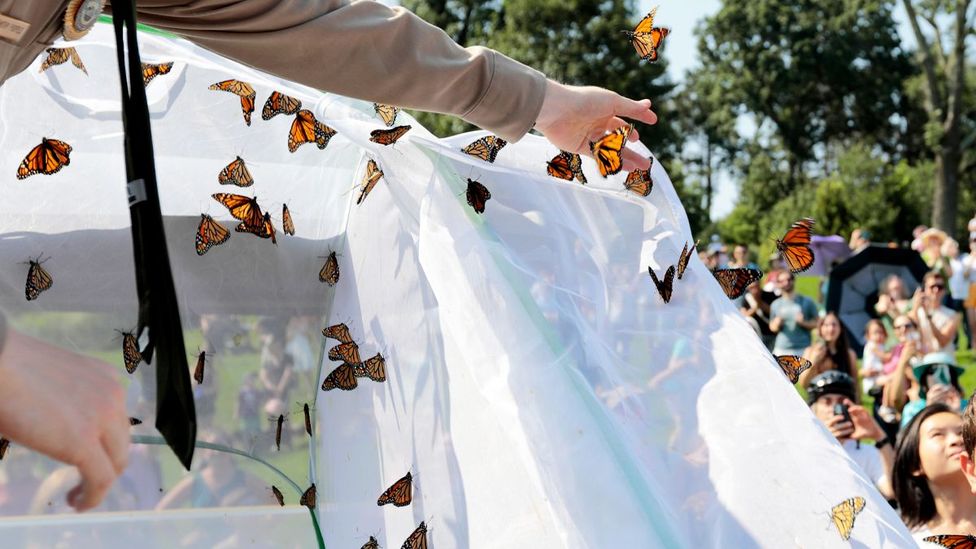
Monarch populations are teetering on extinction, their numbers down to 5% of what they were a few decades ago. Here’s what to know and the simplest way to help.
Decades ago, monarch butterflies were so plentiful that the sound emanating from overwintering groves filled with the brightly coloured insects flapping their wings was described by observers as being akin to a gentle summer rain or a rippling stream. In some cases, tree branches would even collapse under the weight of clusters of monarchs. But recent overwintering counts of the western and eastern migrating monarchs conducted in California and Mexico make clear that gatherings of that magnitude are part of a bygone era.
In the forests of central Mexico, where eastern monarch butterflies have long wintered, the species were estimated to occupy a mere 0.9 hectares (2.2 acres) during the 2023-2024 winter season. That’s 59% less than one year earlier, when the butterflies occupied 2.2 hectares (5.5 acres) – according to the results of an annual survey released this week by the World Wildlife Fund and its partners.
The 2023-2024 winter figures not only represent the second-worst year ever recorded for the butterflies in central Mexico since monitoring began in 1993, but the report is also considered a benchmark for the overall health of the species. There has been a largely downward trend in the fortunes of the eastern monarch since 1996-1997, when the butterflies took over 18 hectares (45 acres) of central Mexican forest.
The report follows the release of the 27th annual western monarch count conducted by Oregon-based Xerces Society for Invertebrate Conservation. The tallies of that effort, which is focused on the overwintering monarch population throughout coastal California, found slightly more than 230,000 butterflies across 256 sites. Here, too, the figures represent a drop from 2023 when the population was around 300,000. Perhaps more importantly, the latest western monarch population amounts to just 5% of what it was in the 1980s, when they were estimated to be found in their millions.
“This is absolutely concerning, but perhaps not surprising,” says Deborah Landau, director of ecological management for the global environmental non-profit The Nature Conservancy, “There are so many factors now adding stress to the monarch population.”
The hopeful news, according to Landau and others involved in studying monarch populations, is that people increasingly appear to understand the importance of pollinators such as monarchs. What’s more, there are a few key steps individuals can take to help save monarchs around the globe.
Monarch butterfly populations are declining, but humans can do one easy thing to help.
The forces driving monarch decline
Two distinct populations, the eastern and western monarchs, are being impacted by the same set of threats: habitat destruction, pesticide exposure and extreme weather brought about by climate change.
When it comes to habitat, there are very few measures in place to stop development of areas critical to butterflies, says Emma Pelton, senior endangered species conservation biologist and western monarch lead for the Xerces Society.
“We do not have comprehensive legal protection for their overwintering sites,” Pelton explains. “Legal protection could help prevent the cutting down of groves of trees that they need.”
In both Mexico and California, a big part of the problem is deforestation driven by logging, urban development and the demand for agricultural land.
Proliferating use of pesticides has also been devastating for monarchs. A report from the Endangered Species Coalition identifies monarchs as one of 10 species imperiled by pesticides, including insecticides, herbicides and rodenticides that are used on crops, commercial and industrial developments, as well as homes and lawns. Some popular herbicides used to target weeds in domestic gardens also kill milkweed, which monarchs depend upon not only as a food source, but to also lay their eggs.
“There are so many more pesticides in use today than historically,” says Landau. “And cumulatively, it’s impacting the monarchs more and more.”
Finally, there are increasingly frequent extreme weather events triggered by climate change, which has also been detrimental to the fragile butterflies. Fluctuations in temperature caused by climate change disrupt and impact the monarch butterfly’s life cycle. At overwintering sites in particular, cold temperatures may cause a switch in the direction of the migration from southward to northward, for instance.
Temperature also impacts the food sources available to monarchs. “These insects are very closely tied to the natural cycles of plants that bloom at certain times and are very dependent on this,” says Landau. “If the plants leaf out or flowers bloom too early, then the monarchs might arrive too late to take advantage of their nectar or leaves. But the opposite is also true, if the monarchs fly early because it’s warm, then they may arrive before the plants are ready to serve as a food source for them.”
Extreme rain events like those California recently experienced can also have a devastating effect, especially if it coincides with colder temperatures in overwintering areas. Monarchs have a hard time surviving such conditions for very long.
“I definitely think climate change could be the straw that broke the camel’s back for monarchs when combined with the problems of habitat loss and pesticide use,” says Pelton.
Ranger Timothy Puopolo releases about 125 monarch butterflies in Kingsley Park.
How to help save monarchs
Despite all the challenges they face, there is hope for the monarchs. Their extinction is not a foregone conclusion, Pelton and other experts say. There is still much that can be done to help shape the monarch’s future.
There is hope, for instance, in the fact that the general public has begun to realise how critical it is to incorporate plants into landscapes and gardens that support monarchs.
Monarch caterpillars are 100% reliant upon milkweed for food. The plants also serve as a host for monarch eggs. And because milkweed plants are inexpensive to purchase and don’t require a great deal of space, they offer an accessible way for the general public to help the butterflies survive.
“Even if you have a postage-stamp-size backyard, every little bit counts,” says Landau, who stresses that using native milkweed is key.
“Sometimes people plant non-native, like tropical milkweed that has a longer growing season, which can disrupt the monarch’s migration pattern because they might not leave when they are supposed to,” she explains.
Non-native milkweed is also more susceptible to a parasite that’s harmful to monarchs, she adds.
Planting nectar-rich flowers and plants is also critical to a monarch’s survival. Like milkweed, these should be native to your area. In California, some of the native options include Yarrow, Sunflowers, Coyote Mint, sunflowers and goldenrod.
“Nectar plants that adult monarchs eat are equally important because if they don’t have that food source, they’re not going to have the energy to make that migration,” says Kelly Bills, executive director of the non-profit Pollinator Partnership, which focuses its efforts on supporting the preservation of all pollinators.
For those where planting is not an option, downloading the Monarch Watch app is another way to help. The app is a community science effort that allows users to contribute data about where and when monarchs are being spotted using geotagging.
All three experts also suggest one last, perhaps less obvious way to help monarchs in the longer term: reducing carbon emissions.
“We know that climate change is driving much of this decline for monarchs and other pollinators, so you can still do your part by taking into consideration – and reducing – the impact of carbon in your daily life,” says Bills.


